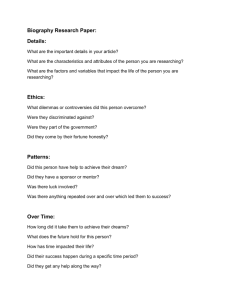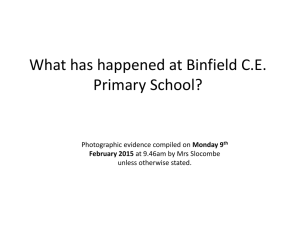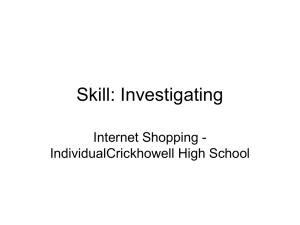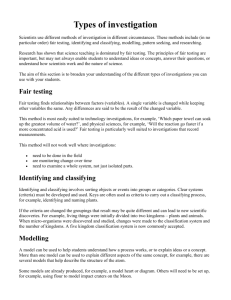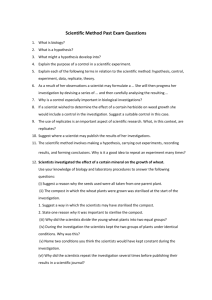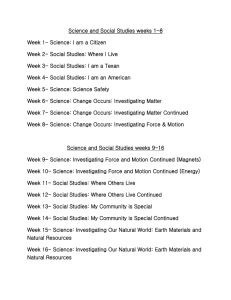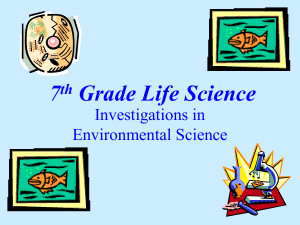Year 6
advertisement
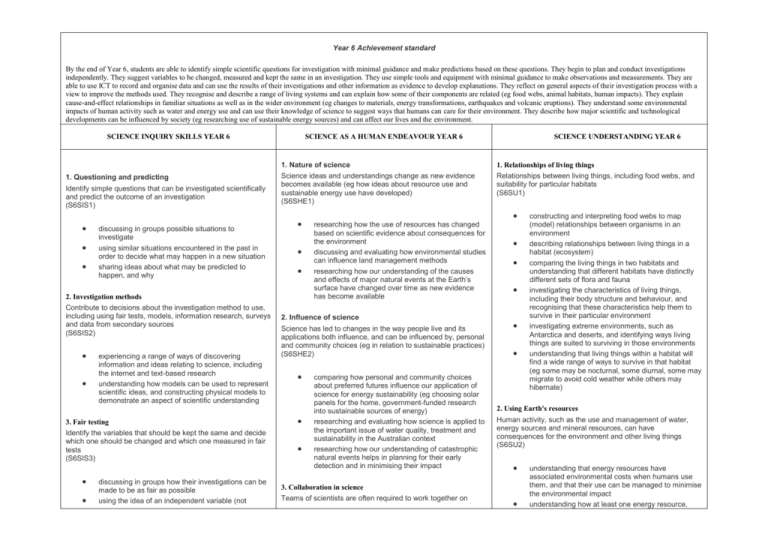
Year 6 Achievement standard By the end of Year 6, students are able to identify simple scientific questions for investigation with minimal guidance and make predictions based on these questions. They begin to plan and conduct investigations independently. They suggest variables to be changed, measured and kept the same in an investigation. They use simple tools and equipment with minimal guidance to make observations and measurements. They are able to use ICT to record and organise data and can use the results of their investigations and other information as evidence to develop explanations. They reflect on general aspects of their investigation process with a view to improve the methods used. They recognise and describe a range of living systems and can explain how some of their components are related (eg food webs, animal habitats, human impacts). They explain cause-and-effect relationships in familiar situations as well as in the wider environment (eg changes to materials, energy transformations, earthquakes and volcanic eruptions). They understand some environmental impacts of human activity such as water and energy use and can use their knowledge of science to suggest ways that humans can care for their environment. They describe how major scientific and technological developments can be influenced by society (eg researching use of sustainable energy sources) and can affect our lives and the environment. SCIENCE INQUIRY SKILLS YEAR 6 1. Questioning and predicting Identify simple questions that can be investigated scientifically and predict the outcome of an investigation (S6SIS1) discussing in groups possible situations to investigate using similar situations encountered in the past in order to decide what may happen in a new situation sharing ideas about what may be predicted to happen, and why SCIENCE AS A HUMAN ENDEAVOUR YEAR 6 1. Nature of science 1. Relationships of living things Science ideas and understandings change as new evidence becomes available (eg how ideas about resource use and sustainable energy use have developed) (S6SHE1) Relationships between living things, including food webs, and suitability for particular habitats (S6SU1) 2. Investigation methods Contribute to decisions about the investigation method to use, including using fair tests, models, information research, surveys and data from secondary sources (S6SIS2) experiencing a range of ways of discovering information and ideas relating to science, including the internet and text-based research understanding how models can be used to represent scientific ideas, and constructing physical models to demonstrate an aspect of scientific understanding Science has led to changes in the way people live and its applications both influence, and can be influenced by, personal and community choices (eg in relation to sustainable practices) (S6SHE2) Identify the variables that should be kept the same and decide which one should be changed and which one measured in fair tests (S6SIS3) discussing in groups how their investigations can be made to be as fair as possible using the idea of an independent variable (not researching how the use of resources has changed based on scientific evidence about consequences for the environment discussing and evaluating how environmental studies can influence land management methods researching how our understanding of the causes and effects of major natural events at the Earth’s surface have changed over time as new evidence has become available 2. Influence of science 3. Fair testing SCIENCE UNDERSTANDING YEAR 6 comparing how personal and community choices about preferred futures influence our application of science for energy sustainability (eg choosing solar panels for the home, government-funded research into sustainable sources of energy) researching and evaluating how science is applied to the important issue of water quality, treatment and sustainability in the Australian context researching how our understanding of catastrophic natural events helps in planning for their early detection and in minimising their impact 2. Using Earth's resources Human activity, such as the use and management of water, energy sources and mineral resources, can have consequences for the environment and other living things (S6SU2) 3. Collaboration in science Teams of scientists are often required to work together on constructing and interpreting food webs to map (model) relationships between organisms in an environment describing relationships between living things in a habitat (ecosystem) comparing the living things in two habitats and understanding that different habitats have distinctly different sets of flora and fauna investigating the characteristics of living things, including their body structure and behaviour, and recognising that these characteristics help them to survive in their particular environment investigating extreme environments, such as Antarctica and deserts, and identifying ways living things are suited to surviving in those environments understanding that living things within a habitat will find a wide range of ways to survive in that habitat (eg some may be nocturnal, some diurnal, some may migrate to avoid cold weather while others may hibernate) understanding that energy resources have associated environmental costs when humans use them, and that their use can be managed to minimise the environmental impact understanding how at least one energy resource, needing to use this terminology) as something that is being investigated by changing it and measuring the effect of this change understanding how changes in other variables can affect investigations and why these need to be kept the same during an investigation 4. Using equipment projects (eg in environmental science, in researching sustainable energy sources and technologies) (S6SHE3) Collaboratively select equipment and materials and use them safely and appropriately, identifying potential risks (S6SIS4) discussing possible hazards involved in conducting investigations and how these risks can be reduced 5. Observing and measuring Use a range of tools to accurately observe, measure and record data and represent it in a variety of ways including tables and graphical methods, using ICT where appropriate (S6SIS5) using familiar tools such as rulers, weighing scales and watches to measure objects and events in investigations adding information to previously constructed tables, graphs and spreadsheets using familiar units such as grams, seconds and metres and developing the use of derived units such as kilograms and millimetres investigating the different roles of scientists who work in teams to identify, monitor and address environmental problems understanding that scientists develop specialised skills and knowledge, and that often teams of scientists are required to work together on projects (eg in researching and managing catastrophic natural events, in researching sustainable sources of energy and in developing sustainable technologies) 3. Major events at the Earth's surface The causes and effects of major natural events at the Earth’s surface such as earthquakes, tsunamis and volcanic eruptions (S6SU3) 4. Contribution of scientists Australian scientists have made a significant contribution to scientific understanding in various fields of human endeavour (eg in agriculture, environmental science, sustainable technology) (S6SHE4) Identify and describe patterns or relationships in observations and data (S6SIS6) exploring institutions and locations where contemporary Australian scientists conduct scientific research relating to catastrophic natural events (eg the Australian Bureau of Meteorology) researching the contribution of Australian scientists (eg Professor Tim Flannery) in investigating the effects of human impact on environments and in investigating sustainable sources of energy and their application researching Aboriginal and Torres Strait Islander individuals who have made significant contributions to developments in western science (eg David Unaipon) Changes to materials caused by heating, cooling or combining can be reversible or irreversible and this influences the use of materials (S6SU4) 5. Science and culture identifying similarities and differences in qualitative data in order to group items and/or materials describing simple cause-and-effect relationships as shown by trends in numerical data 7. Developing explanations Science and culture interact to influence personal and community choices (eg in making decisions about resource use and sustainable management of the environment) (S6SHE6) Compare observations and data with predictions and use as evidence in developing explanations (S6SIS7) sharing ideas as to whether observations match or do not match predictions, and discussing possible compiling a list of examples of major natural events identifying and investigating the causes of some major natural events such as earthquakes, volcanic eruptions, bushfires, droughts and tsunamis investigating ways we measure major natural events exploring ways science can be used in the control and management of major natural events 4. Changing and using materials 6. Analysing results water and one mineral resource can be used and managed using food webs to explain and predict how human changes to habitats can lead to endangered species or extinctions researching how the traditional land management practices and environmental knowledge of Aboriginal and Torres Strait Islander peoples can augment western scientific knowledge and help inform our sustainable management of the environment to minimise human impact considering cultural perspectives and scientific knowledge in reflecting on decisions about the use of resources (eg mining on the traditional land of Aboriginal and Torres Strait Islander peoples) describing what happens when materials are mixed and investigating the solubility in water of a range of common materials understanding that heating and cooling can cause a change in state and that boiling, freezing, melting, evaporating and condensing are all reversible changes understanding that irreversible changes to materials can be detrimental in cases like burning and rusting, but that in others the change is useful (eg baking a cake or making cement) investigating how the way a material changes can influence its use investigating ways Aboriginal and Torres Strait Islander peoples traditionally manipulated native plants to remove toxins and release vapours for medicinal purposes 5. Sustainable energy transformations Sustainable sources of energy, including water, solar and wind, and how they can be transformed into useful forms of energy (S6SU5) investigating how moving air and water can be used reasons if predictions are not found to be correct 8. Communicating Use a range of forms to represent and communicate evidence, ideas and explanations including using models and reports (S6SIS8) using labelled diagrams, including cross-sectional representations, to communicate their ideas and knowledge using a variety of written and spoken text types, including information reports, explanations, arguments, debates and procedural recounts to communicate science ideas making physical models, either individually or in groups, to represent scientific ideas 9. Reflecting on methods Reflect on the process of investigation to evaluate the quality of evidence and to suggest improvements to the planning of investigations (S6SIS9) comparing results with others to get an idea of the reliability of the results describing positive and negative aspects of investigations and working collaboratively to suggest improvements to the methods used recognising that science can inform choices about where people live and how they manage natural disasters, but that some people may have no choice but to live in areas considered as being dangerous to provide power to turn turbines and create electricity understanding that electricity can be generated from sunlight through the use of solar panels investigating other sustainable sources of energy and how they can be transformed into useful forms understanding that sustainable sources of energy are often regarded as the renewable forms of energy and that they can be used without compromising availability of energy sources for future generations
